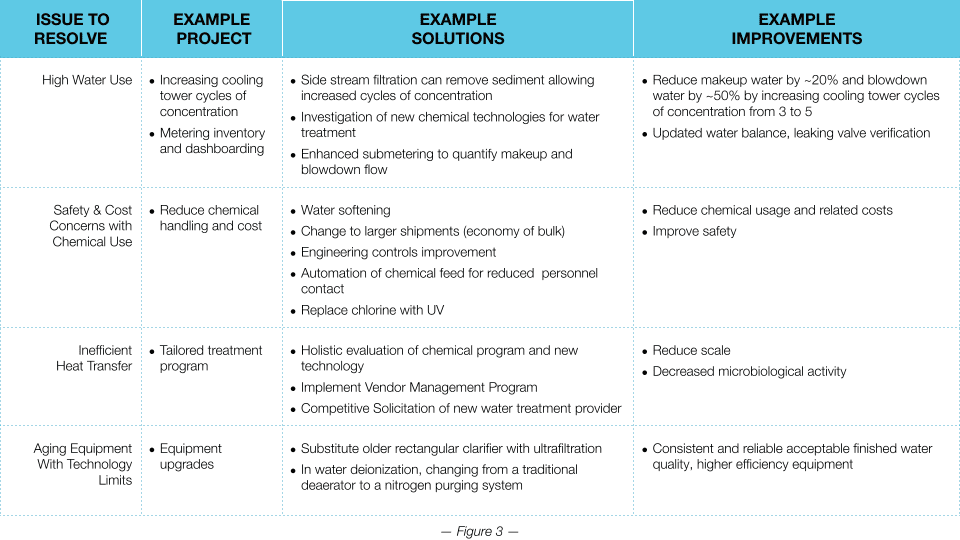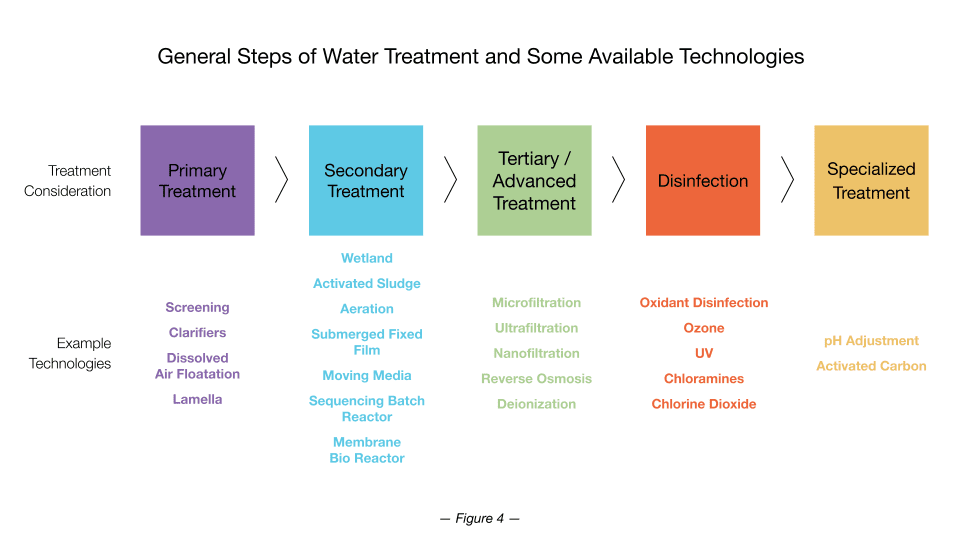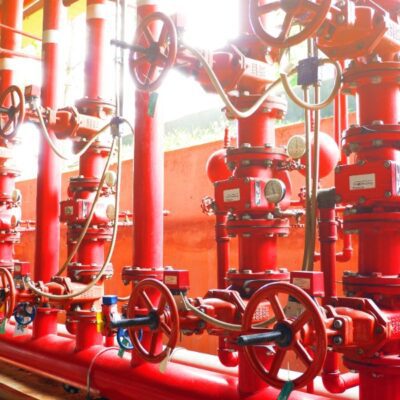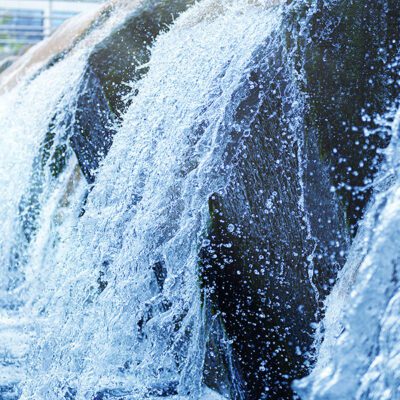The options for improving your organization’s water resiliency are myriad, which makes it especially important to connect corporate goals to tangible facility-level solutions with thoughtful implementation planning. Surveying the diverse landscape of technical and strategic sustainable water solutions will help you identify which are the most appropriate to help you reach your water goals and strengthen your future.
Water is a critical resource that’s too often undervalued, and many organizations are wondering how they can reduce water usage and boost water resiliency to meet upcoming targets. There’s a host of infrastructure and strategic solutions to choose from, and it’s important to understand which of these technologies will work best for your situation.
The solution landscape may seem overwhelming, but reviewing examples can spark conversations about what your organization needs. Deploying any solution at your facility is of course a more nuanced move that will involve change management and technical expertise—but evaluating your situation and reviewing your options will be a first critical step toward meeting your goals and reducing your risk.
Success Requires Both Technical Ability and Alignment of Your People
Selecting and implementing water solutions for your organization requires a highly tailored approach that will vary from site to site and depend on your organization’s goals, local compliance and regulation, funding limitations, and risks to resiliency.
Admittedly, moving a project from conceptual assessment to implementation can be difficult and requires alignment and buy-in across diverse teams of people. As part of Coho’s process, we ensure all key stakeholders are involved in each step leading up to and beyond the critical implementation decision point. Once approved to move forward, competitive sourcing of efforts that vary by solution type can begin.
As an example from our experience, in dealing with large-scale reuse projects, we support clients in creating project specifications and identifying EPC (engineering, procurement, construction) firms to design and implement the solution. Our process generally includes competitive solicitation, counterparty assessments, technology bid evaluations, and technical interviews to understand timing and funding. We combine our technical abilities with our knowledge of the client’s operations to ensure the preliminary engineering and design phases meet the client’s needs.
Uncover the Right Sustainable Water Solutions With Smart Assessment
Not all solutions are for all organizations, and a baseline assessment is important to identify your unique opportunities for improvement. To move forward, you’ll need first to understand your organization’s goals and decision-making criteria. This can mean engaging stakeholders across your organization, from operations staff to sustainability teams, EH&S, procurement, legal, and more to build alignment on your goals, provide the criteria to evaluate solutions, and ultimately find the best fit (your criteria will likely include considerations such as water and wastewater reduction, water risk mitigation, implementation difficulty, business continuity, cost savings, etc.).
When looking at how your organization uses water there are two major areas to evaluate: demand-side and supply-side.
Demand-side water is the volume of water used to satisfy the needs of different equipment and processes. Beyond potable demands, water is often used in manufacturing processes, HVAC systems (e.g., cooling towers, boilers), washing and more.
Supply-side refers to total water available for use at a facility. Supply water can come from many sources including your municipality, ground water, surface water, reclaim water, and stormwater, among others. Many organizations in the industrial, commercial, and institutional sectors rely on water to operate, and so require a focus on alternative sources, sustainable watersheds, and regulatory compliance to ensure operations stay resilient.
Typically, organizations use the bulk of their water for utilities (heating and cooling) and processes, so focusing there to address risk and resilience from both the demand and supply side makes good sense. Many solutions for reducing water use can be tailored to your facility. These usually fall into three categories: Metering, Utility Water Optimization, and Beneficial Water Reuse (Figure 1).

Use Comprehensive Water Metering to Close Data Gaps
When organizations think about water use, they often focus on water in and water out of their sites. However, we know industrial, commercial, and institutional facilities have many different, independent water users within any given site. Accurate data for these intermediate demands form a basis for all other water resiliency plans to be built upon and assessed.
Gathering detailed, reliable data at prioritized locations requires submetering of equipment and processes. A thorough assessment of your site will often uncover unaccounted for or unmetered water use.
If you find data gaps, you’ll need to consider how to fill them by exploring the various available meter technologies. Choosing the right meters requires an understanding of installation location, type of service, long-term use, and data dashboarding needs. Parameters for consideration will often include accuracy, installation ease, calibration requirements, data connectivity capability, and cost-effectiveness. Each of the meter technologies shown in Figure 2 will rank differently across these categories.
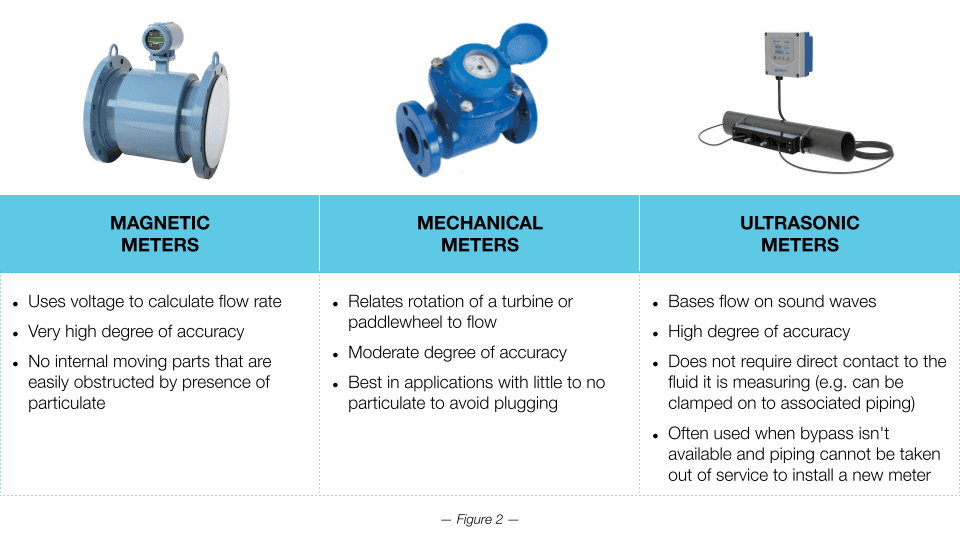
Optimize Utility Water for Efficiency & Savings
Studies show up to 48% of a building’s water consumption in a commercial facility can be attributed to HVAC systems. Evaluation of current site practices will offer you an opportunity to optimize how these systems operate.
Utility water optimization is a tailored process that takes measure of your organization’s specific utility water operations, chemical treatment, and mechanical components. Synchronizing operations, maintenance, facilities, and other key stakeholders to gain insight into the current state of your assets is a critical first step. Using asset data sheets, operational data, and information provided by the water treatment vendor, you can build a baseline of your current utility water operations.
While keeping in mind your organizational goals, you can identify optimization opportunities to save water, lower chemical costs, increase heat transfer and water efficiency, and minimize operational risk. To make the most initial impact, look for opportunities such as inconsistent or low cycles of concentration, scale build up, low heat transfer, evidence of corrosion or fouling, unexplained peaks in water use, chemical safety, handling issues, and more.
Take the example of a cooling tower. The first and easiest way to conserve water in that system is to make sure there are no overflows or major leaks. Next, you must reduce the amount of “blowdown” or waste stream that goes to the drain or other systems of waste collection. Cooling towers constantly replenish fresh water due to evaporation, and blowdown removes concentrated solids from the bulk water. Blowdown is necessary, and reducing it is not as simple as closing a valve. Cooling towers need to be evaluated for how much concentrated solids are in the tower, tower limits based on makeup water quality, and operational needs. This wholistic approach will reveal opportunities to increase the tower’s efficiency, reduce operational risk, and save money on water purchase and chemistry used.
Figure 3 shows examples of utility water use problems our clients have faced, how they were addressed, and the direct and indirect benefits achieved (specifics depend on client situation).
Build a Water Reuse System for Operational Redundancy & Significant Impact
Water use can be reduced greatly by using water originally thought to be waste such as stormwater, industrial wastewater, or blackwater to supply non-potable water demands like cooling towers, boilers, or certain processes. Reuse also reduces associated water purchase and discharge costs and improves water resiliency by creating redundant supply for those systems.
To find reuse opportunities, it’s important to create a water balance by mapping water flows in, out, and within each site. By understanding the amount of water used in non-potable systems and the availability of alternative supplies, you can assess solution sizing, location, and pricing. Specific technologies can then be evaluated for their ability to fulfill an organization’s water quality needs.
When considering an alternative water supply solution (i.e., wastewater), there are several layers of treatment and technologies to compare. The incoming water composition and your use of that water will dictate the level and type of treatment required. Additional considerations include budget, available space for treatment equipment, resource requirements, EHS considerations, permitting implications, and sustainability impacts. Gathering the right stakeholders to weigh in on these considerations will also be key to any reuse project.
Once the boundary conditions have been identified and fit-for-purpose water quality is defined, the right treatment can be assessed. Figure 4 outlines potential levels of treatment required for alternative water sources, which can be achieved using various available technologies. Within these treatment levels, it’s important to assess the benefit of each option against your organization’s defined criteria, which is likely to include parameters such as cost, effluent quality, effectiveness, operating expenses, safety, and footprint.
For example, if available space is a constraint, you’ll need to be thoughtful about primary and secondary treatment selection. With traditional water clarifiers used for settling and solids removal, the system size needed to process a given flow rate of water may be double or triple the size of a comparable Lamella-style system, which differs from a traditional round or rectangular clarifier. It’s important to note that finished water quality from those systems would vary based on how the unit is operated, fluctuations in flow, and chemical treatment.
Making real impact on water use and resilience in your organization may be one of the most important things you can do to safeguard your future. While the journey may feel daunting, there are options available to help make your efforts effective and lasting. The Coho team would be happy to answer any questions you might have regarding water solutions, technologies, and strategies that would work well for you.

